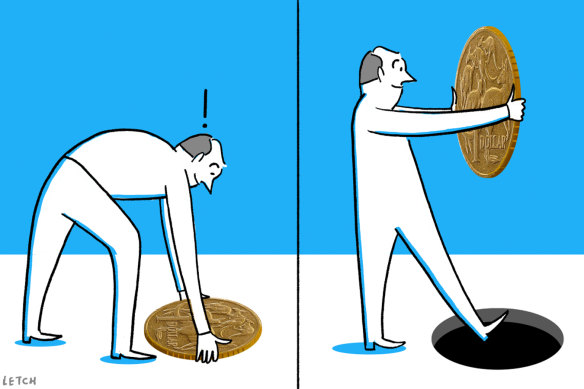This was published 7 months ago
Opinion
Despite what we’re led to believe, tax cuts are no free lunch
Ross Gittins
Economics EditorIsn’t it wonderful that the Albanese government – like all its predecessors – has been willing to spend so many of our taxpayers’ dollars on advertising intended to ensure no adult in the land hasn’t been reminded, repeatedly, about the income tax cuts that took effect on Monday, first day of the new financial year?
But believe me, if you rely only on advertising to tell you what the government’s up to with the taxes you pay – or anything else, for that matter – you won’t be terribly well-informed. The sad truth is there’s a lot of illusion in the impressions the pollies want to leave us with when it comes to tax and tax cuts.

Illustration by Simon Letch
For instance, none of those ads mentioned the eternal truth that, when we have income tax scales that aren’t indexed annually to take account of inflation, the taxman gradually claws back any and every tax cut the pollies deign to give us. And this slow clawback process – known somewhat misleadingly as “bracket creep” – begins on the same day the tax cuts begin.
So readers of this august organ are indebted to my eagle-eyed colleague Shane Wright, who asked economists at the Australian National University to estimate how long it would take these tax cuts to be fully clawed back, using plausible assumptions about future increases in prices and wages.
A tax cut reduces the average rate of income tax we pay on the whole of our taxable income. A middle-income earner’s average tax rate will fall from 16.9 cents in every dollar to 15.5¢. The economists calculate it will take only two or three years for inflation to have lifted most taxpayers’ average tax rate back up to where it was last Sunday.
So that’s the terrible truth the pollies rarely mention. But don’t let that make you too cynical about the tax-cut game. Just because this week’s tax cut will have evaporated in a few years’ time doesn’t mean it’s worthless today. Actually, as tax cuts go, this is quite a big one. Someone earning $50,000 a year is getting a cut worth almost $18 a week. At $100,000 a year, it’s worth almost $42 a week. And on $190,000 and above, it’s worth $72 a week.
Is that enough to completely fix your cost-of-living problem? No, of course not. But if you think it’s hardly worth having, please feel free to send your saving my way. I’m not too proud to take another $18 no one wants.
Remember, too, that had Anthony Albanese not broken his promise in January and fiddled with the stage 3 tax cuts he inherited from Scott Morrison, most people’s saving would have been a lot smaller, even non-existent.
Everyone earning less than $150,000 a year got more, while those of us struggling to make ends meet on incomes above that got a lot less. In my case, about half what I’d been led to expect.
But the politicians’ illusions are built on our self-delusions. Our biggest delusion is that government works quite differently to normal commercial life. We know that when you walk into a shop you have to pay for anything you want. If you want the better model, you pay more.
Somehow, however, we delude ourselves that governments work completely differently. That the cost of the services we demand from the government need to bear no relationship to the tax we have to pay.
The politicians actively encourage this delusion in every election campaign by promising us this or that new or better service without any mention that we might have to pay more tax to cover the cost of the improvement.
Any party foolish enough to mention higher taxes gets monstered – first by the other side and then by the voters. No one wants to admit that what we get can never be too far away from what we pay.
For the near-decade of the Liberals’ time in government, they drew many votes by branding Labor as “the party of tax and spend” while claiming they could deliver us the services we want while keeping taxes low.
This was always a delusion. So they squared the circle by using various tricks they hoped we wouldn’t notice, such as underspending on aged care, allowing waiting lists to build up and secretly ending the low- and middle-income tax offset, thus giving many people an invisible tax increase of up to $1500 a year.
But the main trick they relied on was the pollies’ old favourite: bracket creep.
Get it? When we delude ourselves that we can have the free lunch of new and better services without having to pay more tax, they resort to the illusion that income tax isn’t increasing by letting inflation imperceptibly increase our average tax rate.
This is the tax-cut game. As an economist would say, our “revealed preference” is for no explicit tax increases, but for tax to be increased in ways we don’t really notice and for tax cuts to be only temporary.
Ross Gittins is the economics editor.
Ross Gittins unpacks the economy in an exclusive subscriber-only newsletter. Sign up to receive it every Tuesday evening.